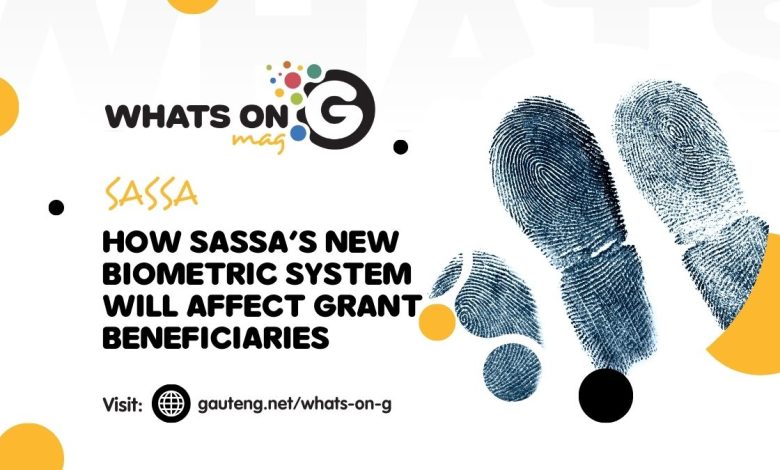How SASSA’s New Biometric System Will Affect Grant Beneficiaries

Starting 1 September 2025, the South African Social Security Agency (SASSA) will introduce a major change to the social grant application process. The agency will require all new applicants to submit biometric data, including fingerprints and facial recognition.

This change aims to strengthen security, prevent fraud, and ensure accountability in the management of the R250 billion social grant system. As a result, millions of South Africans applying for grants will experience a significant shift in the application process.
Why SASSA Is Introducing Biometrics
SASSA’s social grant system handles over R250 billion annually. However, fraud and duplication issues have posed serious challenges. The introduction of biometric enrolment addresses these problems by:
- Improving fraud detection: The system will prevent the use of fake IDs and ghost applicants.
- Verifying beneficiary authenticity: It will provide a reliable “proof of life” system.
- Enhancing accountability: It will strengthen audits and minimize errors in grant disbursements.
Although technical issues and negotiations delayed the rollout, SASSA believes that the biometric system will drastically reduce fraud and improve the accuracy of its processes.
Who Will Be Affected by the New System?
Only new applicants will need to submit biometric data starting on 1 September 2025. Current beneficiaries will not be required to do so immediately. However, the system may expand to include them in future phases. The groups most likely to be impacted include:
- First-time applicants for grants such as child support, old age, or disability.
- Rural applicants, who may face access challenges due to the location of SASSA offices.
- Vulnerable individuals who depend on others to submit applications on their behalf.
How the Biometric Enrolment Process Will Work
The biometric enrolment process will involve several steps:
- Visit a SASSA office: New applicants must apply at a designated SASSA office.
- Submit required documents: Bring identification and other relevant documents.
- Biometric capture:
- Fingerprints will be scanned for verification.
- Facial recognition will be captured and validated using AI technology.
- eKYC system validation: The system will cross-reference biometric data with records from Home Affairs.
- Application review: Applications lacking biometric data will be flagged for review.
- Notification: Applicants will be notified via SMS or an official letter confirming their enrolment status.
Accessibility Considerations: If an applicant is unable to provide fingerprints, such as elderly individuals or manual labourers, facial recognition will serve as an alternative.
Benefits for Beneficiaries
Biometric enrolment offers multiple benefits:
- Fraud prevention: It ensures that funds go to the right recipients.
- Faster, more efficient applications: The process reduces paperwork and speeds up applications.
- Proof of life: It strengthens verification, reducing errors and preventing unnecessary grant stoppages.
- Increased public trust: This system will help build confidence in the integrity of the grant system.
- Future digital grant collection: Beneficiaries may eventually collect grants through mobile wallets, improving payment efficiency.
SASSA’s Infrastructure and Staff Training
SASSA has equipped all its offices with biometric tools. August 2025 will be dedicated to training staff to ensure consistent and efficient implementation of the new system. The agency has also committed to addressing corruption by taking strong action against any officials found colluding with fraudsters.
The Future of Grant Payments
Currently, biometric data will only be required for new applications, not ongoing payments. However, there are plans for expansion:
- Biometric verification could be required when beneficiaries collect grants at retailers or ATMs, reducing fraud and improving efficiency.
- SASSA may integrate banking systems to speed up grant disbursements in the future.
Challenges and Concerns
Despite its many advantages, several challenges remain:
- Rural access: Limited internet and distant SASSA offices may hinder access for some applicants.
- System downtime: The system could experience delays or crashes, affecting the application process.
- Elderly and disabled applicants: Some individuals may face difficulty in providing biometric data.
- Privacy concerns: Applicants may worry about the security of their personal biometric data.
- Union resistance: Labour unions have raised concerns about increased workloads for SASSA staff.
Fraud Prevention at the Core
Biometric data will address several key fraud risks:
- Fake IDs: The system will prevent the submission of forged identity documents.
- Duplicate applications: It will ensure that applicants only appear once in the system.
- Ghost beneficiaries: Biometrics will stop payments to deceased recipients.
SASSA has pledged to prosecute fraudulent officials to maintain system integrity.
Key Dates & What to Expect
The biometric enrolment system will officially launch on 1 September 2025. Key milestones include:
- 1 September 2025: Official rollout of the biometric system for new applications.
- Infrastructure readiness: All SASSA offices are equipped with the necessary tools.
- Future expansion: The biometric system could eventually extend to existing beneficiaries and grant collection.
Applicants who refuse to submit biometric data will have their applications placed under review.
Frequently Asked Questions (FAQs)
Here are answers to some common questions:
- Do current grant recipients need to submit biometrics? No, only new applicants need to submit biometrics.
- What if my fingerprints don’t register? Facial recognition will serve as an alternative method.
- Can someone apply on my behalf? No, biometric data must be submitted in person by the applicant.
- Will my personal biometric data be safe? Yes, SASSA is committed to protecting personal data with secure systems.
- How long will the new application process take? The biometric process may take longer initially, but it will simplify the documentation process in the long run.
- Will this affect how quickly my grant is paid? Not immediately, but it could improve efficiency in the future.
Check also: SASSA to Introduce Biometric System for Grants from September 2025
The biometric system marks a significant step toward improving the security and efficiency of South Africa’s social grant system. While challenges, such as rural access and privacy concerns, remain, the benefits of reducing fraud and streamlining the application process outweigh the potential setbacks.
SASSA is committed to ensuring that grants reach the right people and that the system remains free of corruption and delays.




